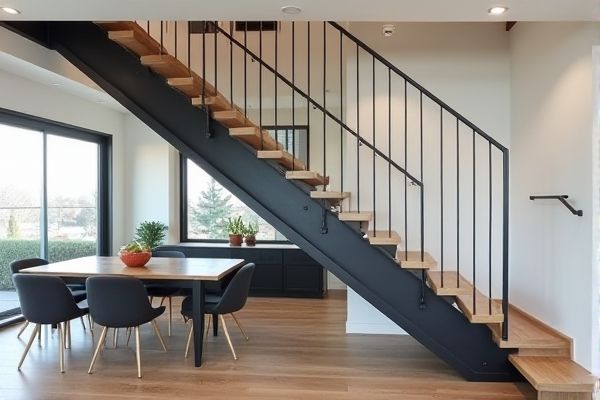
Steel staircases offer exceptional strength and durability, making them ideal for heavy-duty applications and long-lasting use, while aluminum staircases provide the advantage of being lightweight and corrosion-resistant, perfect for outdoor or coastal environments. Explore the rest of the article to determine which material best suits your staircase needs and enhances Your space.
Table of Comparison
| Feature | Steel Staircase | Aluminum Staircase |
|---|---|---|
| Weight | Heavier, provides strong support | Lighter, easier to install and transport |
| Durability | Highly durable, resistant to wear and impact | Corrosion-resistant but less impact-resistant than steel |
| Corrosion Resistance | Requires protective coating to prevent rust | Inherently corrosion-resistant without coatings |
| Maintenance | Needs regular maintenance to avoid rust | Low maintenance, resists corrosion naturally |
| Cost | More affordable material cost | Generally more expensive than steel |
| Aesthetic | Industrial and robust appearance | Modern, sleek, and lightweight look |
| Load Bearing Capacity | Higher load bearing, suitable for heavy traffic | Lower load bearing compared to steel |
| Installation | Requires heavy equipment, longer time | Easier and faster installation |
Introduction to Steel and Aluminum Staircases
Steel staircases offer superior strength and durability, making them ideal for heavy-duty applications and long-term use. Aluminum staircases provide lightweight construction and excellent corrosion resistance, perfect for outdoor or marine environments. Your choice depends on load requirements, maintenance preferences, and environmental exposure.
Material Properties: Steel vs Aluminum
Steel offers superior strength and durability, making it ideal for high-traffic areas or heavy load-bearing staircases, while aluminum is lightweight and resistant to corrosion, perfect for outdoor or moisture-prone environments. Steel's higher density provides excellent structural integrity but may require protective coatings to prevent rust, whereas aluminum's natural oxide layer ensures low maintenance and longevity. Your choice depends on the balance between strength requirements and environmental exposure for optimal staircase performance.
Durability and Longevity Comparison
Steel staircases offer superior durability due to their high tensile strength and resistance to heavy loads, making them ideal for long-term structural applications. Aluminum staircases provide excellent corrosion resistance and are lightweight, but they may not match the longevity of steel in high-traffic or industrial environments. Your choice depends on balancing the need for strength and lifespan with environmental factors and maintenance requirements.
Weight and Structural Considerations
Steel staircases offer superior strength and durability, supporting heavier loads and providing enhanced structural stability ideal for industrial and commercial applications. Aluminum staircases are significantly lighter, reducing the overall structural load and simplifying installation, which benefits residential and lightweight architectural designs. The choice between steel and aluminum depends on balancing weight constraints and required structural performance for the specific project.
Cost Analysis: Initial and Long-Term Expenses
Steel staircases generally have a higher initial cost due to material weight and manufacturing processes but offer greater durability and lower maintenance expenses over time. Aluminum staircases feature lower upfront costs and resist corrosion naturally, reducing long-term repair needs but may require more frequent inspections for structural integrity. Evaluating both options includes considering lifespan, maintenance schedules, and environmental factors to determine overall cost-effectiveness.
Aesthetics and Design Flexibility
Steel staircases offer exceptional design flexibility due to their strength, allowing for intricate patterns, sleeker profiles, and the ability to support heavier loads without bulky supports, which enhances modern architectural aesthetics. Aluminum staircases provide a lightweight alternative with a naturally corrosion-resistant surface, enabling contemporary designs with smooth finishes and customizable colors, ideal for both indoor and outdoor settings. Both materials allow for creative expression, but steel's durability favors complex, industrial-style installations, while aluminum suits minimalist and vibrant design schemes.
Installation Process and Complexity
Steel staircases require heavy-duty tools and skilled labor for welding and securing components, often extending the installation timeline due to the material's weight and rigidity. Aluminum staircases offer a lighter, more modular design allowing for quicker and simpler assembly, typically involving bolted connections rather than welding. Installation complexity of steel increases costs and time, whereas aluminum simplifies the process, making it ideal for projects prioritizing efficiency.
Maintenance Requirements and Lifespan
Steel staircases require periodic rust prevention treatments and painting to maintain structural integrity, especially in outdoor or humid environments, extending their lifespan to around 50 years. Aluminum staircases offer superior corrosion resistance with minimal maintenance needs, such as occasional cleaning, resulting in a lifespan typically exceeding 40 years. While steel is more prone to oxidation without maintenance, aluminum's natural oxide layer ensures durability with less frequent upkeep.
Environmental Impact and Sustainability
Steel staircases typically have a higher environmental impact due to energy-intensive production processes and significant carbon emissions, but they benefit from excellent recyclability and durability that extends their lifespan. Aluminum staircases require less energy to produce and are highly recyclable, resulting in a lower carbon footprint from raw material extraction to end-of-life recycling. Choosing recycled materials and prioritizing manufacturing efficiency enhances the sustainability profile of both steel and aluminum staircases in construction projects.
Choosing the Right Material: Key Factors
Steel staircases offer exceptional strength and durability, making them ideal for heavy-duty use and industrial applications, while aluminum staircases provide lightweight advantages and resistance to corrosion, perfect for outdoor or coastal environments. Consider factors such as load capacity, environmental exposure, maintenance requirements, and aesthetic preferences to determine which material best suits your specific project needs. Your decision should balance long-term performance with budget constraints to ensure the staircase remains safe and visually appealing over time.
 homyna.com
homyna.com